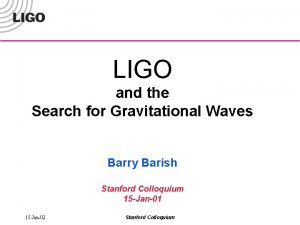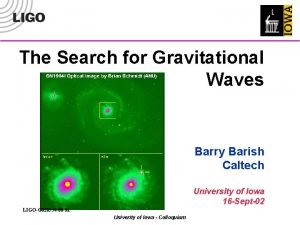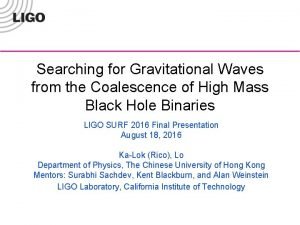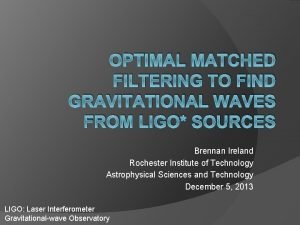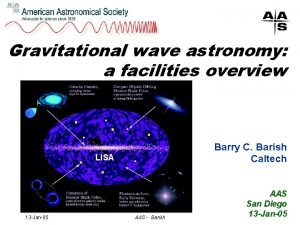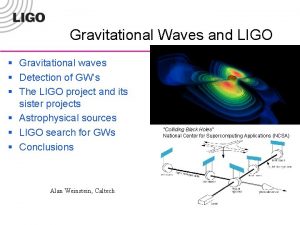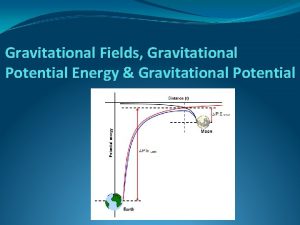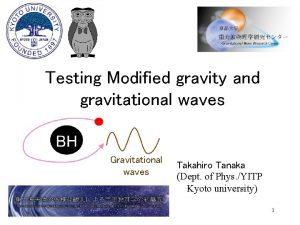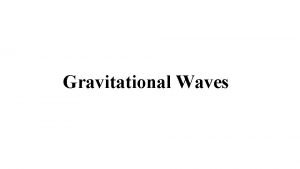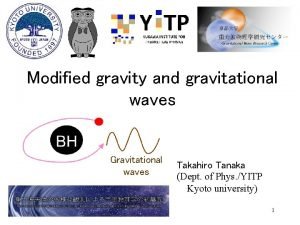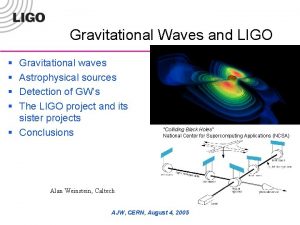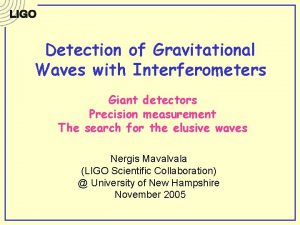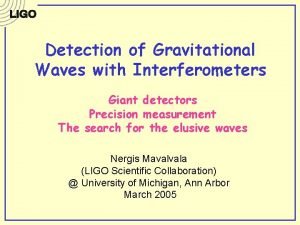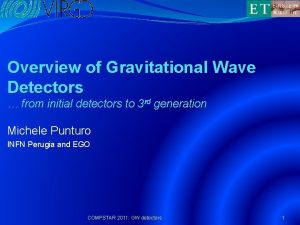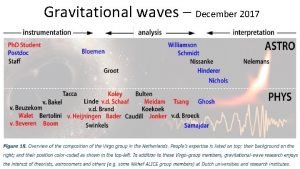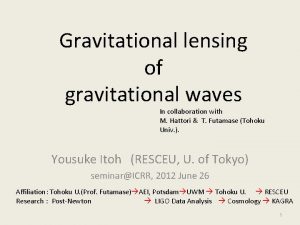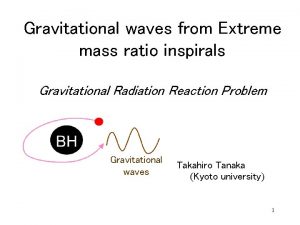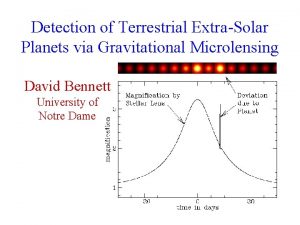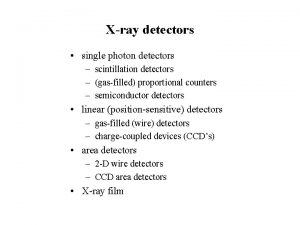Detection of gravitational waves News from terrestrial detectors


























![Log [Strain (1/rt. Hz)] Advanced LIGO Target Sensitivity Initial LIGO Advanced LIGO Newtonian background Log [Strain (1/rt. Hz)] Advanced LIGO Target Sensitivity Initial LIGO Advanced LIGO Newtonian background](https://slidetodoc.com/presentation_image_h/045e925b82125976f103e9c796e182e5/image-27.jpg)





- Slides: 32

Detection of gravitational waves News from terrestrial detectors Nergis Mavalvala (on behalf of the LIGO Scientific Collaboration) Quantum to Cosmos 2, June 2007

Basics of GW Detection § Gravitational Waves “Ripples in space-time” § Stretch and squeeze the space transverse to direction of propagation Example: Ring of test masses responding to wave propagating along z Want very large L

Global network of detectors GEO LIGO VIRGO TAMA AIGO LIGO • Detection confidence • Source polarization • Sky location LISA

GW detector at a glance Seismic motion -ground motion due to natural and anthropogenic sources Thermal noise -vibrations due to finite temperature power recycling mirror Shot noise -quantum fluctuations in the number of photons detected


What limits the sensitivity? Seismic noise Suspension thermal Viscously damped pendulum Shot noise Photon counting statistics

Gravitational-wave searches Instrument and data

Science runs and Sensitivity

S 5 duty cycle GEO 600 ~ 95%

Transient § Coalescence of binary compact objects (neutron stars, black holes, primordial BH) § Core collapse supernovae § Black hole normal mode oscillations § Neutron star rotational instabilities § Gamma ray bursts Campanelli et al. , Lazarus Project § Cosmic string cusps High duty cycle Astrophysical searches § Periodic emission from pulsars (esp. accretion driven) § Stochastic background (incoherent sum of many sources or very early universe) § Expect the unexpected! GWs neutrinos photons now

Sampling of current GW searches Pulsars

Continuous Wave Sources § Single frequency (nearly) continuous GW radiation, e. g. neutron stars with § Spin precession at § Excited modes of oscillation, e. g. r-modes at § Non-axisymmetric distortion of shape at § Compare with spin-down limits § Assuming all energy lost as the (PSR J 2124 -3358) pulsar spins-down is dissipated f = 405. 6 Hz, r = 0. 25 kpc via GWs § Get limit on ellipticity of rotating star

Sampling of current GW searches Binary Inspirals

Search for Binary Inspirals § Sources § Binary neutron stars (~1 – 3 Msun) § Binary black holes (< 30 Msun) § Primordial black holes (< 1 Msun) BBH § Search method § Look for “chirps” § Limit on rate at which stars are coalescing in galaxies like our own S 2 S 4 24 galaxies like our Milky Way BNS

Sampling of current GW searches Stochastic Background

Cosmological GW Background 10 -22 sec 10+12 sec Waves now in the LIGO band were produced 10 -22 sec after the Big Bang WMAP 2003

Predictions and Limits LIGO S 1: Ω 0 < 44 PRD 69 122004 (2004) 0 Pulsar CMB+galaxy+Ly-a Timing -4 adiabatic homogeneous -6 LIGO S 3: Ω 0 < 8. 4 x 10 -4 PRL 95 221101 (2005) Log (W 0) -2 -8 -10 BB Nucleosynthesis LIGO S 4: Ω 0 < 6. 5 x 10 -5 (new) Initial LIGO, 1 yr data Expected Sensitivity ~ 4 x 10 -6 Cosmic strings CMB Pre-BB model -12 Inflation -14 Slow-roll EW or SUSY Phase transition -18 -16 -14 -12 -10 -8 -6 -4 -2 Log (f [Hz]) Adv. LIGO, 1 yr data Expected Sensitivity ~ 1 x 10 -9 Cyclic model 0 2 4 6 8 10

Coming soon… to an interferometer near you Enhanced LIGO Advanced LIGO

Why a better detector? Astrophysics § Factor 10 better amplitude sensitivity § (Range)3 = rate § Factor 4 lower frequency bound § Hope for NSF funding in FY 08 § Infrastructure of initial LIGO but replace many detector components with new designs § Expect to be observing 1000 x more galaxies by 2013

Initial LIGO – Sept 15 2006 Input laser power ~6 W Circulating power ~ 20 k. W Mirror mass 10 kg Initial LIGO

Enhanced LIGO Input laser power ~ 30 W Circulating power ~ 100 k. W Mirror mass 10 kg Enhanced LIGO

Advanced LIGO Input laser power > 100 W Circulating power > 0. 5 MW Mirror mass 40 kg Advanced LIGO

In closing. . . § Astrophysical searches from early science data runs completed § The most sensitive search yet (S 5) begun with plan to get 1 year of data at initial LIGO sensitivity § Joint searches with partner observatories § Planned enhancements that give 2 x improvement in sensitivity underway § Advanced LIGO approved by the NSB § Construction funding expected (hoped? ) to begin in FY 2008 § Promising prospects for GW detection in coming years

Ultimate success… New Instruments, New Field, the Unexpected…

The End

Enhanced LIGO § Make some upgrades with limited invasiveness to give ~2 x improvement § Mechanical changes ruled out § Seismic isolation and suspension systems § Changes mainly related to optical readout
![Log Strain 1rt Hz Advanced LIGO Target Sensitivity Initial LIGO Advanced LIGO Newtonian background Log [Strain (1/rt. Hz)] Advanced LIGO Target Sensitivity Initial LIGO Advanced LIGO Newtonian background](https://slidetodoc.com/presentation_image_h/045e925b82125976f103e9c796e182e5/image-27.jpg)
Log [Strain (1/rt. Hz)] Advanced LIGO Target Sensitivity Initial LIGO Advanced LIGO Newtonian background Quantum noise Mirror substrate thermal Seismic 10 Mirror coating thermal Suspension thermal 100 Frequency (Hz) 1000

How will we get there? § Seismic noise § Active isolation system § Mirrors suspended as fourth (!!) stage of quadruple pendulums § Thermal noise § Suspension fused quartz; ribbons § Test mass higher mechanical Q material, e. g. sapphire; more massive § Optical noise § Laser power increase to ~200 W § Optimize interferometer response signal recycling

Seismic Noise Initial LIGO Advanced LIGO

Signal-recycled Interferometer Cavity forms compound output coupler with complex reflectivity. Peak response tuned by changing position of SRM 800 k. W 125 W ℓ signal Signal Recycling Reflects GW photons back into interferometer to accrue more phase

Advance LIGO Sensitivity: Improved and Tunable broadband detuned narrowband thermal noise

Advanced LIGO Quantum noise limited Shot noise Radiation pressure noise Advanced LIGO
 Wave could hear murmurs across universe
Wave could hear murmurs across universe Gravitational waves
Gravitational waves Barry univerity
Barry univerity Gravitational waves
Gravitational waves Matched filtering gravitational waves
Matched filtering gravitational waves Gravitational waves
Gravitational waves Chromatography mobile phase and stationary phase
Chromatography mobile phase and stationary phase Feature detectors
Feature detectors What is streaming potential
What is streaming potential Where are feature detectors located
Where are feature detectors located Giant wave detectors murmurs universe
Giant wave detectors murmurs universe Frontier detectors for frontier physics
Frontier detectors for frontier physics Photo detectors
Photo detectors Vhv voltage detectors
Vhv voltage detectors Kinesthesis and vestibular sense
Kinesthesis and vestibular sense Yodsawalai chodpathumwan
Yodsawalai chodpathumwan Nuclear detectors
Nuclear detectors Rhmd: evasion-resilient hardware malware detectors
Rhmd: evasion-resilient hardware malware detectors Photo detectors
Photo detectors Compare and contrast p waves and s waves using venn diagram
Compare and contrast p waves and s waves using venn diagram Mechanical waves and electromagnetic waves similarities
Mechanical waves and electromagnetic waves similarities Example of mechanical wave
Example of mechanical wave Long waves and short waves
Long waves and short waves Surface waves and body waves
Surface waves and body waves What do all waves transmit
What do all waves transmit Mechanical waves and electromagnetic waves similarities
Mechanical waves and electromagnetic waves similarities Difference between matter waves and electromagnetic waves
Difference between matter waves and electromagnetic waves What waves do not require a medium
What waves do not require a medium What are constructive waves
What are constructive waves What type of waves are sound waves? *
What type of waves are sound waves? * Seismic waves are mechanical waves
Seismic waves are mechanical waves Mechanical waves vs electromagnetic waves
Mechanical waves vs electromagnetic waves Longitudinal vs transverse wave
Longitudinal vs transverse wave

